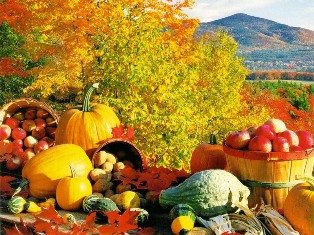How to Prepare Your Body for Winter?
When we observe nature carefully, it is clear that our diet needs to change in the fall. In nature, as summer transitions into winter, birds fly thousands of miles, whales cross oceans and leaves fall off trees. Fall is a time of transition when we need to transition our diet to remain in balance during the winter months.
In Autumn, with winter coming, nature is informing us to alkalize our body. A diet based on the fall harvest will pull heat out of the body which will prevent winter dryness, detoxify the liver, improve lymphatic drainage, flush the intestinal tract and reduce inflammation. These actions will prevent against colds and flu and thus prepare us for the dry and cold months ahead.* 
Generally, in Autumn you want to eat smaller portions of protein and grains while eating more fresh fruits and vegetables. Some of the most suitable foods to alkalize the body in the fall are kale, beets, celery, alfalfa and all types of sprouts. Fall is also good time for vegetable juicing to alkaline, cleanse and cool the body after summer.
As winter begins your dietary needs change as the cold and dryness arrive. Notice that the winter harvest is predominately acidic foods like grains, meats, fish, dairy, and eggs. Traditional these are the foods used to survive colder climates, as vegetables and fruit were sparse. Winter is the time to build the body's stores of proteins and fat. These high fat foods help insulate the body from the cold and protect against colds, constipation, dry skin and achy joints.* If you are a vegetarian, it is critical that your diet contains many high sources of proteins and fat during the winter months.
VATA BODY-TYPE FALL/WINTER EATING GUIDELINES
A predominately Vata body-type needs to start to carefully follow the Vata reducing dietary guidelines in the fall as winter is the Vata period when Vata conditions like dry skin, achy joints and even anxiety can be exasperated by the cold and dry climate.* A Vata body-type needs to be extra careful about eating plenty of protein, healthy fat and oil to maximize warmth and moisture during the winter months. This means eating plenty of heavy and moist foods such as bananas, avocados, beets, winter squash, nuts, meat, deep-sea fish and oils. In winter, however, Vata body-types want to avoid milk and cheese.
KAPHA BODY-TYPE FALL/WINTER EATING GUIDELINES
A predominantly Kapha body-type or someone with a Kapha imbalance such as extra weight can not follow a winter diet strictly and needs a modified version of the Kapha reducing diet for the winter months. In the fall, however, a Kapha body-type can eat lots of apples and pears and to some degree peaches to help cool off from the summer, alkalize the blood and clean the intestinal track. This prepares the body for the heavier foods needed to stay warm in the winter. Keep in mind that when spring comes it is the time for the Kapha body-type to strictly follow a Kapha reducing diet (no wheat, dairy, nuts, meat etc) and shed any extra weight and mucus accumulated in the winter.*
PITTA BODY-TYPE FALL/WINTER EATING GUIDELINES
For a predominantly Pitta body-type cooling off from the summer is critical before winter arrives. If a Pitta body-type goes into the winter without cooling off first, the combination of accumulated summer heat and the dryness of winter can be devastating for the Pitta. During the fall, the Pitta dominated person needs to strictly follow the Pitta reducing diet with cooling foods and lifestyle habits right up until the colder winter months arrive. Favor foods that are sweet, bitter, or astringent like white basmati rice, barley and oats. Enjoy the last of the summer fruits like grapes, cherries, melons, coconuts, pomegranates, mangoes, sweet oranges, pineapples and plums. Reduce sour fruits like grapefruits and unripe olives. For vegetables favor asparagus, cucumbers, green leafy vegetables, broccoli, cauliflower, celery lettuce and beans while reducing hot peppers, tomatoes, spinach and most root vegetables particularly warming ones like garlic and radish. Winter for the Pitta-type is generally balancing for the Pitta's often heated condition if they have cooled and alkalized completely in the fall. Then during the winter the Pitta can enjoy the foods from the winter harvest and remain balanced.
Related articles:
Dietary guidelines for the winter according to Ayurveda
Preventing and Recovering from the Common Cold and Flu
If you would like assistance establishing a proper fall and winter diet suitable for your body-type and health condition, please contact me for a private session.
Khabir


















